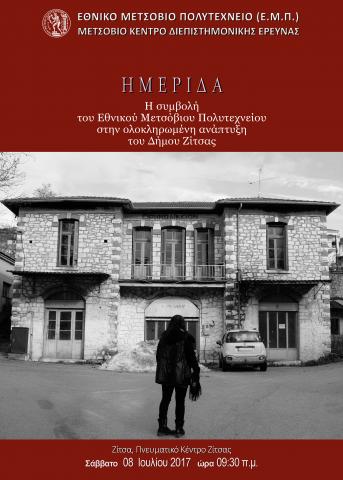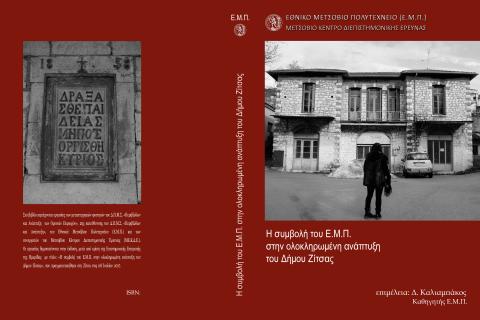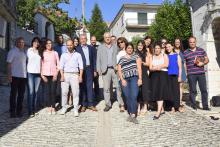The Contribution of the National Technical University of Athens to the Integrated Development of the Zitsa Municipality
Dreams and expectations of the youth
The depopulation and the aging of the population is a typical characteristic in the mountainous areas of Greece. The prospects for the conservation and development of mountainous regions are closely connected with the stay of young people in these regions. For this reason, the teenagers are the objective of study in this paper, as they will be the future residents of the area of the Municipality of Zitsa. More specifically, this paper examines the views, the difficulties, the thoughts, the problems, the dreams, the way of life and the expectations of the students of High School, of the Municipality of Zitsa. The paper sheds light on the pupils and highlights what makes them happy in the place where they live and what their main concerns for the future are. The results are particularly interesting and important, as a policy tool to the direction of the stay and the return of young people in this mountainous area.
Environmental pressures on the aquatic ecosystem of Kalamas in the Municipality of Zitsa
Water resource management is a complex and demanding procedure. Hence, continuous monitoring and updating of the anthropogenic pressures on water bodies is necessary, including both the current state and the response. The case study of Kalamas water body is strongly connected with the natural and the socioeconomic environment in the Municipality of Zitsa. In this context, this paper presents the composition of an inventory of point and diffused human-induced pressures for four major parameters affecting water quality. The contribution of several activities to the pollution of Kalamas river is also assessed. Furthermore, the river's quality status is presented according to recent measurements, and an integrated plan for dealing with existing pressures is proposed.
Βiogas production from poultry residues
The operation of several poultry farms in the Municipality of Zitsa, combined with the occasional uncontrolled disposal of waste from poultry farming activity, lead to a major environmental problem in the area. In the present work the option of treatment of poultry residues, while producing energy through biogas burning is presented. After analyzing the characteristics of poultry waste, reference is made to the effects of the soil disposal of this untreated waste. Then, the process of the Anaerobic Digestion is shortly described, and the benefits of biomass utilization with this method are analyzed. The various parts of a biogas plant are also described. Furthermore, the available biomass potential of the Municipality of Zitsa is calculated, as well as the biogas that can be produced. The basic biogas plant characteristics responding to the biogas potential of Zitsa are presented and dimensioned. Finally, a cost-benefit analysis of the power plant is carried out.
Irrigation of Zitsa's plateau
Access to irrigation water is an advantage. Water is a tool and a means of ensuring ideal conditions for plant growth and optimization of yield. Sources of irrigation water are potentially all water resources, surface, underground and reclaimed. In the Zitsa’s plateau, the absence of a collective irrigation system entails high watering costs. For this reason, the present work investigates the feasibility of collective irrigation work, given the available resources, the limitations of existing legislation, the possibilities of exploiting financial sources, and the estimated impact of the project on society. The solution that has been addressed is the on-stream reservoir, in which, for the full coverage of needs, the simultaneous use of three small reservoirs is required.
Exploitation of winery waste
The wineries of the Municipality of Zitsa, owing to their significant wine production, have to manage large volume of winery waste, mainly grape marc and wine lees. Winery waste is currently burdening wineries’ operating costs, while it could be used to produce new high added-value products through an appropriate process. In this respect, the present paper explores the feasibility and viability of a winery waste process plant at Zitsa, in order to produce grape seed oil extract, grape oil extract and polyphenols. The analysis is performed for three different capacity scenarios, drawing data from primary market surveys and secondary sources. The results indicate that the proposed plant is an attractive investment, with additional environmental and social benefits that should not be ignored.
Development perspectives of the agricultural sector
Through the last decades the Greek rural space has been suffering a constant decline in economic, social and environmental terms, as well. An important and characteristic aspect of the problem is the desertion of agricultural land. The Municipality of Zitsa is considered to be affected by this general rule, with minimal exceptions. Within this context, the present paper consists of an effort to investigate the obstacles and problems of Municipality’s primary sector, in order to reveal critical parameters that could potentially contribute to the improvement of the current situation, given that proper measures are put into action. The research outcomes are expected to open a dialogue on the agricultural sector’s development prospects, not only in the area of study but also on a broader level.
Examining the interdependence relationship between Eleoussa - Ioannina
One of the basic objectives of spatial planning is to explore the tendencies of attraction and repulsion between urban centers and their satellite settlements. In this framework, the paper examines the developing relationship of interdependence between the city of Ioannina and the settlement of Eleousa. The historical and residential evolution of the settlement has been examined, as well as the current situation regarding the demographic characteristics, the population growth, the economic activities, the employment rates and the infrastructure. Through in-situ survey with questionnaires, local sectors individuals' views were examined on issues and parameters (i.e. education, health, recreation, infrastructure, etc.) which contribute to Eleousa’s autonomy as well as its dependence upon Ioannina. The paper points out the key-parameters that determine the settlement’s level of autonomy. Despite the fact that, Eleousa is autonomous in several fields such as education, although depends on Ioannina for employment, recreation etc. It is estimated that the autonomy of the settlement can be enhanced by a long-term strategic planning that will contribute positively to local development by utilizing the natural and cultural environment of Eleousa.
Accessibility issues in Zitsa municipality
The concept of accessibility has been the subject of research by many researchers in terms of measurement and quantification, which depending on the purpose and needs of the researcher can be measured through many indicators and methods. In this research, we in order to quantify the accessibility of the Municipality of Zitsa, an accessibility model has been developed, exclusively for Zitsa, by using the general form of the gravity-based models. The research indicates that the combination of a weighted activity function and the travel cost adjusted with Distance Decay offer the more representative accessibility/ remoteness results for the municipality of Zitsa. The developed model is customized for the characteristics of the area, since a special analysis has taken place to identify all the relevant infrastructures and services inside the municipality as well as the surrounding regions. Finally, we show the impact of remoteness in two important aspects of regional development – the human capital and the economy.
Rehabilitation of the Vrosina Camp
The summer camping, with which the majority of Greek people are familiar from their childhood, is an experience of entertainment, play, pleasure and adventure. A creative educational process, which apart from an enjoyable learning experience, is also a reference point in the “formation” of independent, self-confident and mentally and physically healthy children. Mountain campings benefited by the particular elements of the natural and cultural environment of the mountains offer a complex space of escape especially for those children who live in the city. This paper, examines the rehabilitation and conversion of Vrosina’s abandoned camp into a summer camp, by making use of the natural beauty of the area, the forests, the rivers and the surrounding mountains. The main idea of this rehabilitation proposal is the utilization of the existing building stock and its uses. At the same time, it is examined whether the summer camp could be also used by the Hunting Associations active in this area in order for the built facilities to be fully utilized all year round and not only during the summer months. Contrary to the general public view on the hunters, an attempt is being made in order for the positive impact of their activity in the region, the development and the nature to be pointed out.
Redevelopment of Zitsa’s old market street
Zitsa is a settlement with a unique nature and a rich history, located in Epirus. Over time the character of the village changed, as this standalone commercial node of the past, turned out as another residential satellite of Ioannina. The municipality of Zitsa recently went after the revitalization of the village’s commercial road by repairing the exterior of the dilapidated buildings that have been radiating the sense of abandonment for many years. In this particular project, it is suggested that the borough of Zitsa moves a step further by interfering with the settlement’s commercial road, aiming to the retrieval of its physiognomy, having regards for the modern needs of the local community. The proposal consists of acts that concern the redevelopment of the commercial road, and directions of aesthetic improvement of the street front. For this reason, a new topographic diagram has been designed, on which prepared the architectural preliminary road redevelopment and the selected faces. The project was completed with the drafting of the detailed budget of the work provided for in the proposal, with a view to drawing up an integrated implementation study.
Restoration suggestions of the Klimatia’s inactive quarries
In the last few years, in Greece, the quarries that are not used anymore, is a usual picture. It is a picture of an absolutely dry area and lunar landscape, which is perimetrically surrounded not only by dense flora, which usually includes coniferous trees and bushy vegetation but also rare fauna. The absolute contradiction between the quarry area and the surrounding space is becoming understandable and observable, through the visual eyesore that is created by the whole picture. Subsequently, as long as the quarries are not used, a territorial and visual problem is created, not only for the municipality, but also for the area to which they belong and for the local community which is affected either because the local people do not work in them or because people or tourists are not attracted because this area is not developed. The problem of quarries that are unused and abandoned, can be faced through their restoration which can be realized with various ways and different methods. Except for the restoration of quarry areas, there is the possibility these areas to be developed if the people construct recreational facilities which will contain sports and cultural events. We can meet examples like this, not only internationally but also in the country’s borders as well. As far as this project is concerned, we are going to examine the quarry in Klimatia of the municipality of Zitsa in which surveys and measurements were accomplished. The possibilities, the perspectives and the ways of restoration will be analysed, based on a central keystone, on which the whole plan of the complete restoration will be constructed.
Derveni: The revival of “The road of salt”
Nowadays, the growing demand for rural tourism has transformed existing and new paths into one of the main development axes of the areas they cross. This paper aims to map the Derveni trail, the historical path that used to connect the port of Sagiada with the city of Ioannina, focusing on the parts in the Municipality of Zitsa. In this context, historical travel records and road indicators were used in combination with state-of-the-art technical standards. At the same time, the possibility of its usage as a form of alternative tourism is studied and the importance of its promotion is analyzed, using methodical actions and best practices.
πινeΖίτσα: An app for the Municipality of Zitsa
Citizen participation in public matters is a sign of a healthy and democratic local government. However, participation cannot always be effective, because of various spatial and temporal constraints. Constraints can be even more amplified in rural areas where long distances and bad quality road network can further complicate the attentiveness of citizens in public meetings. Participation through ICT (e-participation) can help to alleviate the issues of the physical presence and positively contribute in the decision-making processes of the local government. In this study, we present an app for m-participation for the municipality of Zitsa. The app has been developed according to the state-of-the-art methods and best practices, taking into consideration the special characteristics of the Zitsa municipality. Residents may use the app to report issues in their area “on the go” and, at the same time, to actively participate in the decisions through voting and commenting.
Development perspectives of the "Kostas Malamos” engraving gallery
The "Kostas Malamos" Engraving Gallery of the Municipality of Zitsa, constitutes the realization of his vision for cultural decentralization. Malamos was a great painter but also an engraving collector. In 1995 the idea for the Art Gallery was born and in 2006 it started its operation. Since then, the collection of engravings has grown and there is no longer enough space for the artworks. The symposium in 2013 is the benchmark during the Gallery’s operation period. Unfortunately, the Gallery remains closed for many months since its opening, due to lack of staff. Bodies engaged in the Gallery’s operation should be mobilized to provide sustainable solution to its major problems. Cooperation with other organizations in the area of Ioannina and sponsorship programs will contribute to its development. Finding solutions to the Gallery’s operational problems is an utter necessity. Otherwise, its administration will come up against the closure of this important facility.
Land use conflicts in the region of Zitsa
The publish of forest maps has raised a number of issues with regard to existing land uses. Areas that prove to be arable by aerial photographs of 1945/1960, today have become forest. Residents of various rural areas protest against this development and ask for the reformation of forest maps in order to be able to use the land for agriculture. The development of viticulture in the Zitsa vineyard has provided international recognition to local vine varieties and the wines of the region have been designated products of Protected Designation of Origin (PDO). In this paper, the Vineyard Zone of Zitsa’s area were digitized, by the use of Geographical Information Systems, including the areas classified as forest. Unstructured interviews were conducted with professional Foresters and the ownership status was investigated in the area to identify possible declassification solutions for the forest fields.
Once upon a time... the fairy tale of Monovyza
In many mountainous areas, and mainly in Epirus, the myth of Monovyza exists that appears in books and oral traditions. In, almost, every region there is a different version of the myth. However, the core idea remains the same in all of them: Monovyza is a very strong woman with supernatural power. She has only one breast (therefore her name - One breast woman) which she puts on her back. She has a son whom she loses, either because a dragon takes him or because other people kill him in a battle (it differs in each version of the myth). Monovyza gets very angry and decides to take revenge by damaging with rage whatever there is in her way. She is so strong and full of anger that she removes rocks and places. Her legend remains alive for many generations and her name is bound up with the biggest catastrophe, the biggest harm ever done. In the frame of this paper, based on the myth, a fairy tale, about Monovyza, for children has been written and illustrated.



















